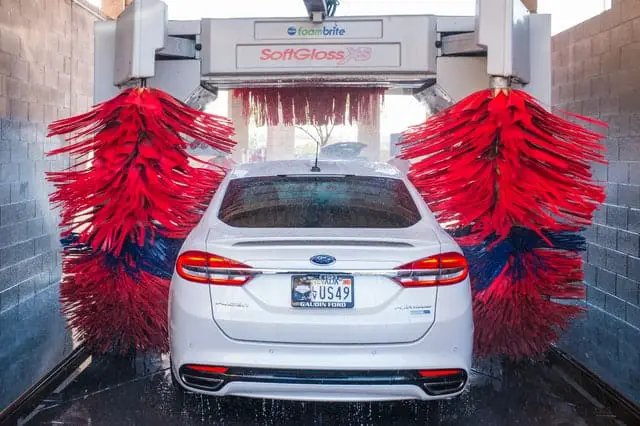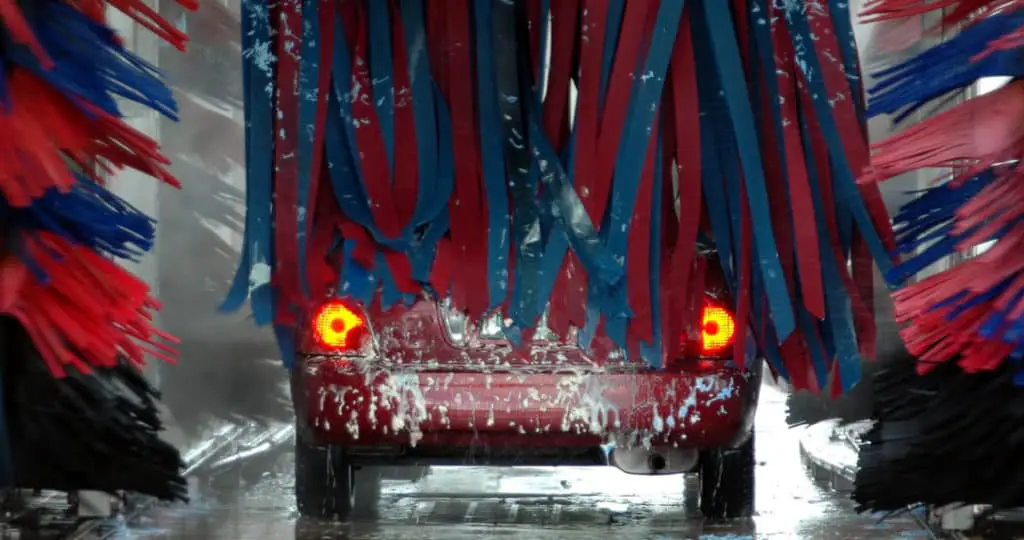Last Updated on March 19, 2025 by Nate Schnell
When was the last time you thought about cleaning the undercarriage of your car? Most drivers rarely consider it—after all, it’s out of sight, out of mind. Yet your car’s undercarriage is one of the most vital areas of your vehicle. Keeping it clean isn’t just about aesthetics; it’s about safety, durability, and long-term vehicle maintenance.
With over ten years in the automotive detailing industry, I’ve seen firsthand the costly consequences of neglecting your vehicle’s undercarriage. In this comprehensive guide, I’ll explain exactly why undercarriage cleaning is crucial, show you how to perform a thorough and safe cleaning at home, and highlight when professional help might be best.
Why Cleaning Your Car’s Undercarriage is Essential
Your car’s undercarriage houses critical components, such as your brake lines, fuel lines, suspension system, and exhaust components. It’s also continuously exposed to harsh elements like road salt, grime, mud, moisture, and even chemicals from roadways. These contaminants accumulate over time, triggering corrosion and rust—often silently and unnoticed until significant damage has already occurred.
Regularly cleaning your undercarriage helps remove these harmful substances before they cause costly damage. Rust can spread rapidly, weakening vital structural parts and significantly shortening your vehicle’s lifespan. By maintaining a clean undercarriage, you’re actively protecting your car’s integrity, ensuring safety, and preserving its resale value.
Step-by-Step Guide to Safely Cleaning Your Car’s Undercarriage at Home
Check for a Skid Plate and Remove if Needed
Many modern vehicles have skid plates that protect sensitive undercarriage components. Before washing, check your vehicle owner’s manual. If your car has a skid plate and the manufacturer allows its removal, doing so will improve cleaning access significantly. Just remember to reinstall it properly afterward.
Safely Lift Your Car
Ideally, use a car lift or professional-quality jack stands to elevate your vehicle. Raising your car improves access and prevents damage that might be caused by spraying water at close range. If you don’t have these tools available, thoroughly clean the ground beneath the vehicle before starting to prevent debris from spraying upward.
Optional: Remove Wheels for Deeper Cleaning
Though optional, removing your wheels greatly improves your access to wheel wells, which frequently accumulate grime, mud, and road salt. With wheels off, it’s also a good opportunity to inspect suspension components, rotate tires, or address other maintenance tasks that are easier to perform when wheels are off.
Rinse Thoroughly with a Pressure Washer or Hose
Use a pressure washer set at moderate pressure (around 1,500 to 2,000 PSI) to effectively rinse debris from your undercarriage. Maintain a safe distance—about two feet—to avoid damaging sensitive parts. If a pressure washer isn’t available, a standard garden hose works as well, though you may need to gently brush stubborn dirt or road salt manually.
Warm water is ideal, as it loosens grime more effectively. Take your time rinsing, making sure all major dirt and debris are removed before applying any cleaner.
Apply a Specialized Undercarriage Cleaner or Degreaser
After rinsing, apply a dedicated automotive undercarriage cleaner or a safe degreaser like WD-40. These products loosen tough grime, grease, and contaminants that ordinary rinsing may leave behind. Allow the cleaner to sit briefly—usually 2 to 5 minutes—to break down dirt fully.
Avoid household degreasers that could harm plastic or rubber components. Automotive-specific cleaners are designed to protect these areas, helping extend their lifespan.
Rinse Again Thoroughly
Once the cleaning agent has done its job, thoroughly rinse your undercarriage again. This removes all traces of cleaner along with any remaining grime. Be careful to rinse well—leftover residue can attract dirt, defeating your efforts.
Dry the Undercarriage Completely
Proper drying is essential, as trapped moisture can accelerate rust development. Use compressed air, a leaf blower, or a specialized car dryer for best results. These tools help remove moisture from hard-to-reach areas. If these tools aren’t available, microfiber towels can be used, but air-drying remains superior.
Apply a Protective Undercarriage Spray
After drying, apply an undercarriage protectant or corrosion inhibitor. Products specifically formulated for automotive undercarriages provide a protective barrier against moisture, salt, and grime. WD-40 is commonly used, but specialized products offer even better long-term protection.
How Often Should You Wash Your Car’s Undercarriage?
The general rule of thumb is to clean your car’s undercarriage regularly enough to prevent corrosion. Practically speaking, this means roughly every two weeks in winter months—especially if your roads are salted or heavily treated. In milder climates or during summer, a monthly cleaning should suffice.
Regular maintenance significantly reduces the likelihood of corrosion-related damage. It’s always easier—and cheaper—to prevent rust than to fix it later.
Risks of Neglecting Your Undercarriage
Ignoring undercarriage maintenance isn’t harmless. Corrosion caused by salt and grime buildup can lead to severe problems, such as:
- Brake Line Corrosion: Rusted brake lines can leak or rupture, causing brake failure—a major safety hazard.
- Fuel Line Damage: Corroded fuel lines can leak gasoline, risking fires or engine trouble.
- Suspension and Frame Weakness: Rust weakens critical structural parts, affecting your vehicle’s handling and safety.
Regular undercarriage cleaning helps you avoid these costly, potentially dangerous issues.
Are Automatic Car Washes Safe for Undercarriage Cleaning?
Many automatic car washes offer undercarriage cleaning as a convenient alternative. High-quality automatic washes use powerful jets positioned beneath your car to safely remove dirt and salt without brushes that can snag sensitive components.
However, automatic washes aren’t without risks. Some older or poorly maintained facilities use abrasive brushes or insufficient rinsing, potentially causing swirl marks or inadequate cleaning. If choosing an automatic wash, look for modern facilities advertised as “touchless” or specifically “undercarriage friendly.”
When to Consider Professional Undercarriage Cleaning
Professional auto detailing shops are another excellent option, particularly if your vehicle is heavily soiled or if you suspect corrosion has already started. Professionals typically have specialized tools and experience to handle the task thoroughly, safely, and efficiently.
During professional detailing, experts will inspect your undercarriage carefully, ensuring components such as brake lines, fuel lines, and exhaust systems remain intact and undamaged. They can spot early signs of rust and recommend treatments, such as protective sprays, rust inhibitors, or even ceramic undercoatings.
FAQs on Car Undercarriage Maintenance
Can You Apply Ceramic Coating to an Undercarriage?
Ceramic coatings or specialized undercoatings can significantly enhance protection against rust and grime. It’s usually best applied by professionals due to specialized equipment and surface preparation required.
Is It Possible to Wash the Undercarriage Too Often?
Regular washing doesn’t harm your undercarriage if done correctly. Frequent cleaning helps prevent rust formation, prolonging the life of your vehicle. Just avoid overly aggressive washing that could damage parts.
Should I Paint My Car’s Undercarriage?
Most car undercarriages already have protective paint or coatings from the manufacturer. While additional painting or coating by professionals can increase protection, it’s usually not necessary if you maintain regular cleaning and proper care.
Can You Clean an Undercarriage Without a Hose?
Though technically possible, using a hose or pressure washer is recommended. Without them, achieving thorough results is difficult. Consider an automatic car wash if hose-based cleaning isn’t available at home.
Final Thoughts on Car Undercarriage Maintenance
Cleaning your car’s undercarriage isn’t just optional—it’s a fundamental part of responsible vehicle ownership. Regular attention prevents corrosion, preserves critical components, and ensures your car remains safe and reliable for many years. Whether you clean at home, visit an automatic car wash, or rely on professional detailing services, taking action today helps you avoid costly repairs tomorrow.
For additional professional tips, consult:
A clean undercarriage today means fewer headaches down the road—literally.



